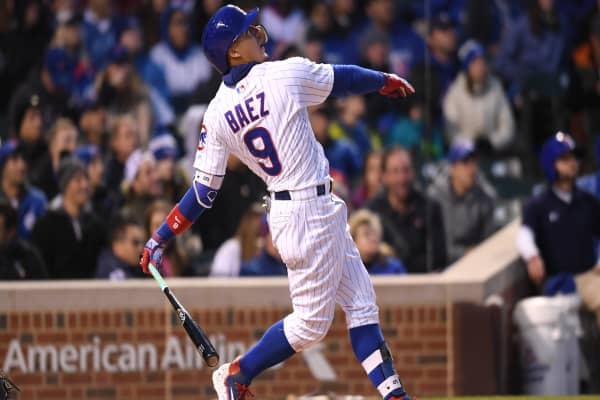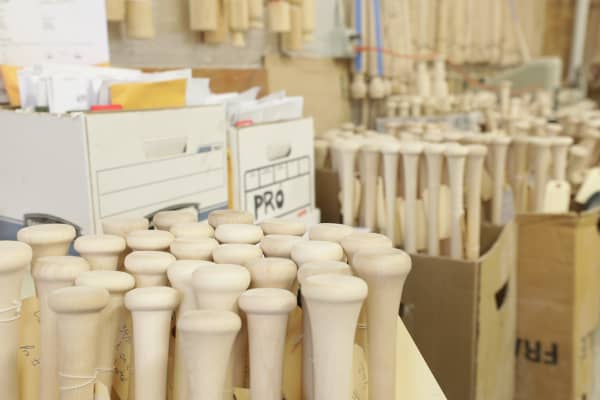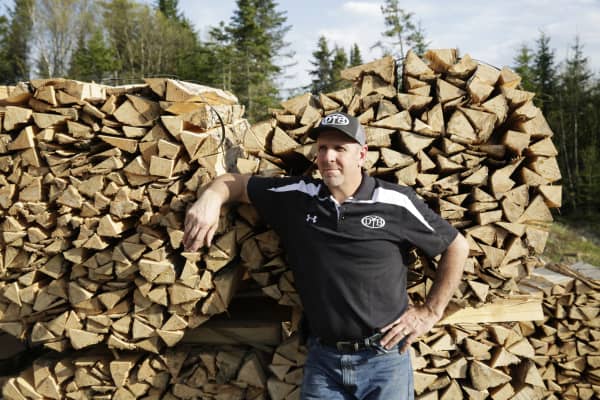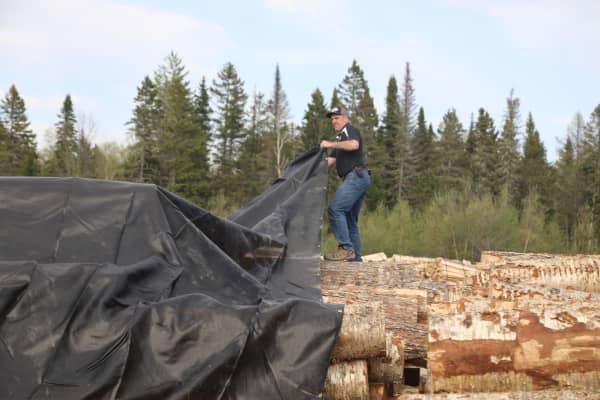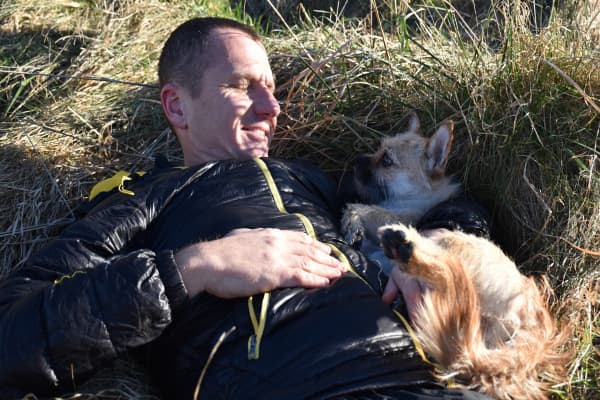Kansas City Royals first baseman Eric Hosmer’s home run during a game against the Cleveland Indians this past May was one of the season’s most epic. And it wasn’t just because of the distance and velocity — an estimated 469 feet at 110 mph — it was also because of the bat.
Hosmer wasn’t using a Louisville Slugger or a Marucci, brands that dominate the league. He was using a bat from an ambitious up-and-comer, Dove Tail Bats.
The moment was particularly sweet for Paul Lancisi, a one-time MLB hopeful and carpenter-turned-baseball-bat-maker who made the bat Hosmer was swinging.
“To me this is a lifestyle,” Lancisi tells CNBC Make It, “it’s not just a business. We have personal notes from the players thanking us for the product that we produce.”
Lancisi has in just six years gone from producing baseball bats as a side gig to selling to some of the biggest names in Major League Baseball. He is one of only 33 bat suppliers certified to sell to MLB players. With a staff of just 11 employees and a couple of traveling sales reps, Lancisi will produce more than 31,000 bats this year.
He has two baseball bats in the Hall of Fame, and a third one likely on the way. In September, Kansas City Royals left fielder Alex Gordon hit the 5,684th home run of the season, breaking the single-season home run record. He did it with a Dove Tail Bat.
Building the best bat
Lancisi, 56, built his company in Shirley Mills, Maine, a densely wooded town of 233 residents about 60 miles from the Canadian border.
“I remember the first time holding a baseball bat,” he says. “I was about six years old. I got to play a game that later on in my life becomes my livelihood and livelihood for a bunch of other people.”
Lancisi started making bats in 2007 for his son Nick, who was a high school baseball player at Foxtrot Academy in Maine at the time. Nick would routinely complain that the bats he was using were dried out and kept breaking. After college he headed to California to pursue baseball professionally and had an idea for his father.
“He said ‘Dad, this can be really a big thing. You can send bats to me, and I can sell them to my buddies and make money,'” Lancisi recalls.
He built that first bat for his son using maple stock originally destined to become table legs. It was a hit, and after that, Lancisi, a furniture maker who started working in carpentry at age 16, began regularly sending bats to California. Nick would sell them to his teammates “for really cheap.”
“He started getting a lot of good input from other players,” Lancisi says. “They gave us the validity that this is a really good product — the wood is different than any other bats they’ve ever swung. They said it was much better than what they’re used to swinging, the mainstream bats, the names that everybody sees. That’s when we started to really push.”
He and his wife, Theresa, sold their 20-year-old furniture and kitchen cabinet company to focus exclusively on bats.
According to Lancisi, what sets a Dove Tail bat apart is the maple and birch wood, sourced from the same lumber yard in northern Maine used by famed piano maker Steinway.
Quality wooden bats need to balance elasticity and stiffness. Harvard physics professor John Huth says the best are durable, crack-resistant and put robust power behind the ball upon contact. Slow-growing wood tends to produce these qualities. The often frigid climate in the far Northeast creates the ideal growing conditions for a slow-growing wood that has a finer, straighter grain than tends to be found in warmer climates, says Huth.
Lancisi works hard to produce wooden bats of top-grade quality. He works closely with his lumber source to ensure the wood that comes to his factory is top-grade quality. Employees cut, shave and sand the wood into billets, the cylindrical pieces of wood that will become bats. The billets are dried in a kiln for 14 days and stored in a humidity-controlled room until orders come in. They’re later tested to ensure the grain of the wood is straight enough to meet the MLB’s standards.
Finally, the bat is sprayed with a finish, a secret formula Lancisi developed, now in its third iteration that lends Dove Tail’s bats their final layer of hardness — the condition that creates that famous “pop” associated with a home run. Each bat is handled over 200 times before it’s shipped.
Not everyone agrees that the wood a bat maker uses creates a significantly different experience. Alan M. Nathan, professor emeritus of physics at the University of Illinois at Urbana-Champaign and author of the site The Physics of Baseball says “the differences among different players is far greater than the differences in the bats that they use in terms of their performance.”
“More importantly than the type of wood probably is simply the way the bat feels in their hands,” he says, “and the way the bat feels as you’re trying to swing it.”
For some players, DTB’s bats just feel right.
Brett Phillips, an outfielder for the Milwaukee Brewers, started working with DTB four years ago, while he was still in the minor leagues. He’d previously used an array of bats — Old Hickory, Victus, Phoenix, Zinger, Louisville Slugger — but says he hasn’t used another bat since turning to Dove Tail.
“I just think that DTB is slightly harder and better than the rest of those other bats,” Phillips says. “Guys will pick up my bat and use it in [practice] and be like, ‘Holy cow,’ and they’ll end up calling their agent and asking to send them six.”
Playing in the Major Leagues
Beyond building what he calls “a lucrative business,” bat making was a dream come true for Lancisi, a one-time MLB hopeful. In 1977, he was vetted by the New York Yankees to be a pitcher. In 1982, he tried out for the Boston Red Sox. Both attempts were unsuccessful. Now, 32 years later, he has finally found his way into the MLB.
Lancisi manufactures the bats in the same building that once housed his furniture company, where displays of cabinets and countertops still greet visitors at the entrance. Approximately 60 percent of his sales come from minor league players, 30 percent from retail stores and 10 percent from MLB players. His professional model bats sell for between $85 and $145.
Focusing so keenly on the minor leagues is part of Lancisi’s strategy. Unlike many of its competitors, Dove Tail sells the same quality bats to amateurs and minor leaguers as it does to MLB players.
“If you have enough product infiltrated in every organization, and the product’s good enough,” Lancisi says, “as these kids start going up the system, they’re going to remember the product that they had and what got them there.”
To become a vendor with the MLB, you have to pay approximately $14,000 in application fees up front, plus enough money for insurance, according to Lancisi — a buy-in of roughly $30,000. That money came directly out of his furniture business and was a “huge risk,” Lancis says. He and his wife, Teresa, opted out of borrowing the funds and instead paid it all themselves.
“We didn’t even make enough to cover that $30,000, let alone all the material and everything else we bought,” Lancisi says of his first year selling to MLB players.
Popularity grew by word of mouth, and according to Lancisi, 70 percent of the runs scored by the Kansas City Royals in the 2015 World Series were scored with a Dove Tail bat. That put the company on the map, and, soon after, Lancisi was inundated with inquiries from investors. Today, he and Teresa retain 60 percent of the company.
His clients include Chicago Cubs third baseman and 2016 league MVP Kris Bryant, Washington Nationals right fielder and 2015 MVP Bryce Harper and Red Sox legend Manny Ramirez, who now plays professionally in Japan.
Chicago Cubs third baseman and 2016 league MVP Kris Bryant, pictured using a DTB bat. Photo by Joe Sargent/Getty Images
The first time Ramirez, a grand slam hitter, called, Lancisi couldn’t believe it was really him. The fact that one of baseball’s biggest names, and one of Lancisi’s favorite players, was on the phone with him marked a crucial moment in his personal journey.
“I was in shock,” he says. “I’m like ‘No way!’ He goes, ‘Honest, Papi, it is me.'”
Dove Tail’s home run
Lancisi won’t disclose his margins, but says he’s earning a healthy profit. All profits go back into the business, he says, to upgrade machinery and expand the facility. He currently sells to 75 MLB players and in more than 15 countries, including Japan.
But while it may be the bats that draw players to DTB, it’s Lancisi’s commitment to the craft that keeps them around.
“I stick with [Lancisi] because of the relationship I have with him,” White Sox second baseman Tyler Saladino tells CNBC Make It. “You’re getting to deal with someone who really, genuinely cares. He wants the best for you at all times. You can always call.”
Dove Tail is banking on that kind of loyalty as insurance against its far bigger competitors. In February, DTB’s then-closest competitor, Victus Sports, was bought out by Marucci, which sees Victus as a “new disruptive innovative brand.”
But Lancisi doesn’t plan to part from his company anytime soon.
“You know, having top players that faithfully buy our product — that’s what my goal is,” he says, “to have a core group of guys that say, ‘You know what? This is the real deal.'”
Check out 5 sports lessons a former pro athlete uses to succeed in business
Like this story? Like CNBC Make It on Facebook.

